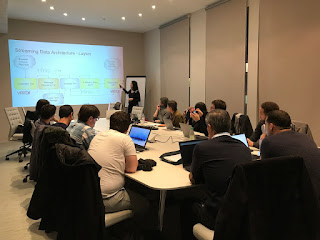It's been a very busy year from an Infinispan evangelisation perspective, so before the year ends, we wanted to round up the conferences and user groups that featured Infinispan related talks. This is a good opportunity to catch up on what we've been showing in our Infinispan outings:
@ Devoxx France
This was our first outing of the year with Emmanuel and I showing the audience at Devoxx France the different use cases for data grids. This was also the first time we showed swiss train related demos which we'd improve throughout the year. Slides can be found here and video below:
@ Great Indian Developer Summit
@ Berlin Buzzwords
@ Red Hat DevNation Live
In this talk, I focused on the big data related use cases for Infinispan. I showed how Infinispan could be used for near real-time data processing using Continuous Querys, and how to analise data using distributed Java Streams. Slides can be found here and the demo here. The video from the DevNation talk can be found here:
@ Red Hat Summit
In this hands on lab, Ugo et al showed how to build a highly available and scalable complex event processing engine with Red Hat JBoss BRMS and and Red Hat JBoss Data Grid (the commercial supported version of Infinispan). This workshop resulted in unmissable architecture reference guide.
@ Great Indian Developer Summit
@ J On The Beach
Patterns d’utilisation de systèmes in memory
by Emmanuel Bernard and Galder Zamarreño@ Devoxx France
This was our first outing of the year with Emmanuel and I showing the audience at Devoxx France the different use cases for data grids. This was also the first time we showed swiss train related demos which we'd improve throughout the year. Slides can be found here and video below:
Big Data In Action with Infinispan
by Galder Zamarreño@ Great Indian Developer Summit
@ Berlin Buzzwords
@ Red Hat DevNation Live
In this talk, I focused on the big data related use cases for Infinispan. I showed how Infinispan could be used for near real-time data processing using Continuous Querys, and how to analise data using distributed Java Streams. Slides can be found here and the demo here. The video from the DevNation talk can be found here:
HACEP: Highly available and horizontally scalable complex event processing
by Ugo Landini, Sanne Grinovero, Andrea Leoncini, Andrea Tarocchi@ Red Hat Summit
In this hands on lab, Ugo et al showed how to build a highly available and scalable complex event processing engine with Red Hat JBoss BRMS and and Red Hat JBoss Data Grid (the commercial supported version of Infinispan). This workshop resulted in unmissable architecture reference guide.
Learn how to build Functional Reactive Applications with Elm, Node.js and Infinispan
by Galder Zamarreño@ Great Indian Developer Summit
@ J On The Beach
The aim of this talk is to demonstrate how Infinispan's Node.js client could be combined with Elm and Infinispan server instances to build a functional reactive application. The talk focused on how build a CRUD application using Elm and Node.js technologies and using Infinispan in-memory data grids for storing and querying information. Slides can be found here:
Streaming Data Analysis with Kubernetes
by Galder Zamarreño
This talk is a spin off of the big data in action talk which focuses on exploring in greater detail how streaming data can be analysed within a Kubernetes orchestrated cluster. The demo can be found here and the slides here:
Data grids : descubre qué esconden los datos
by Galder Zamarreño
This talk is a Spanish spin off the analytics part of the big data in action talk. Not only did it showed how to use distributed Java Streams to analyse data with Infinispan, but also demonstrated the capabilities of Spark/Hadoop integrations. The demos can be found here and here, and the slides here:
Streaming Data : ni pierdas el tren, ni esperes en balde
by Galder Zamarreño
A Spanish version of the streaming data analysis talk delivered in Basel One.
This talk was recorded, so hoping for the video to be available soon.
Update (2018/02/02): The video is now available here:
In the mean time, the demo can be found here and the slides here:
Update (2018/02/02): The video is now available here:
In the mean time, the demo can be found here and the slides here:
Streaming Data Workshop
by Katia Aresti, Thomas Segismont and Galder Zamarreño
A hands-on workshop showing how to work with streaming data with Infinispan and Vert.x, on top of OpenShift container platform. No videos were recorded but you can follow this workshop step by step following instructions here. The Github repository can be found here and the latest slides here:
There's plenty the to keep you entertained between now and the new year! :)
If you have any doubts about the talks above, or you encounter any issues running the demos, do not hesitate contacting us! In the mean time, the Infinispan team is working hard on Infinispan 9.2 as well as improving our OpenShift integration.
If you have any doubts about the talks above, or you encounter any issues running the demos, do not hesitate contacting us! In the mean time, the Infinispan team is working hard on Infinispan 9.2 as well as improving our OpenShift integration.
Cheers,
Galder




















